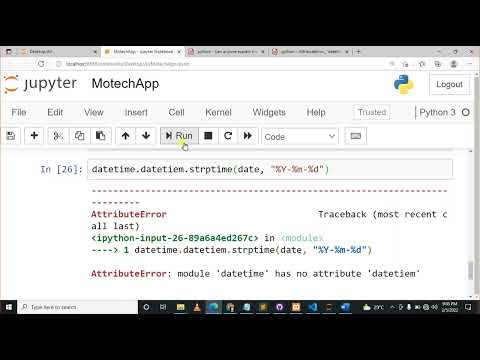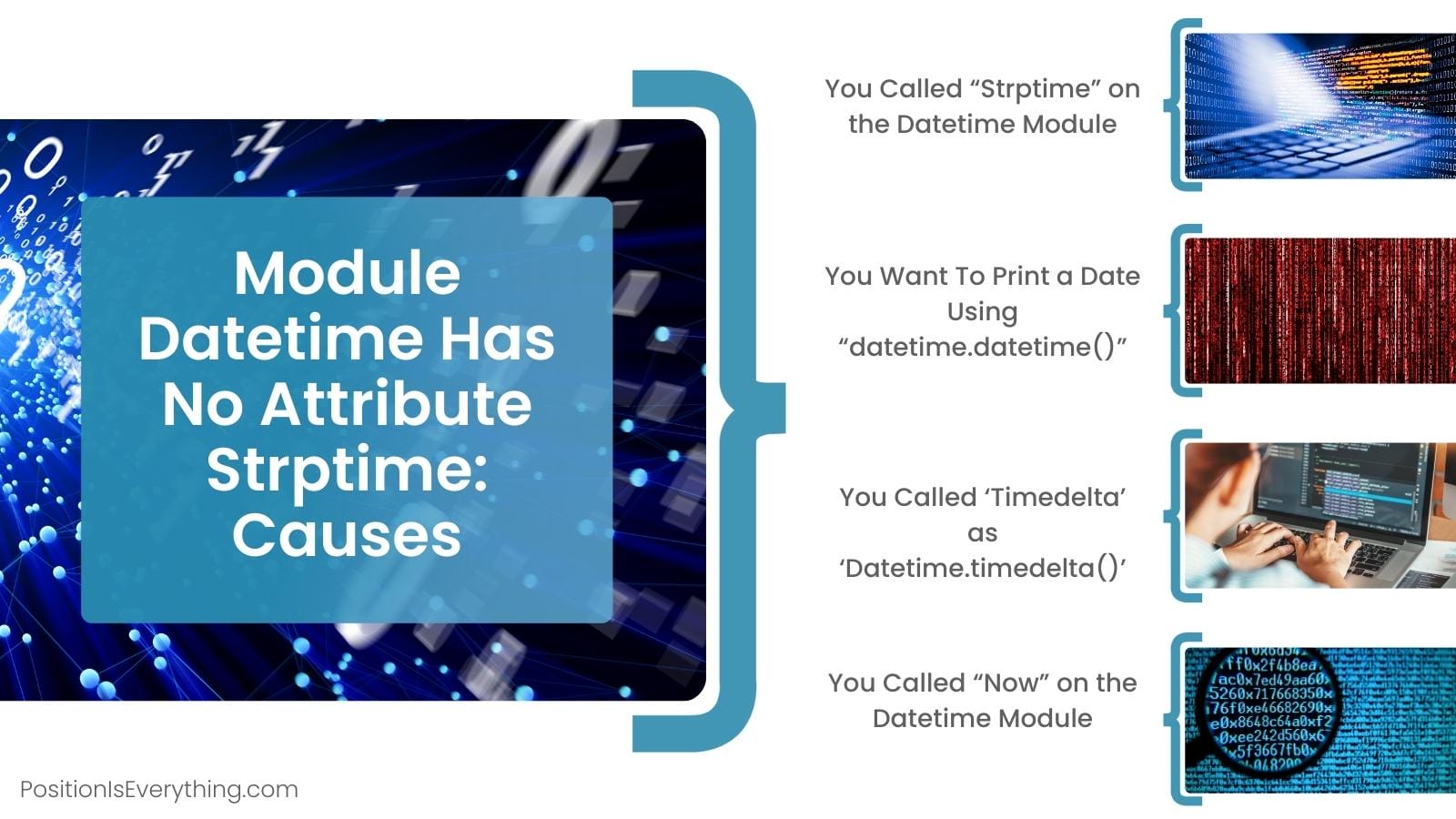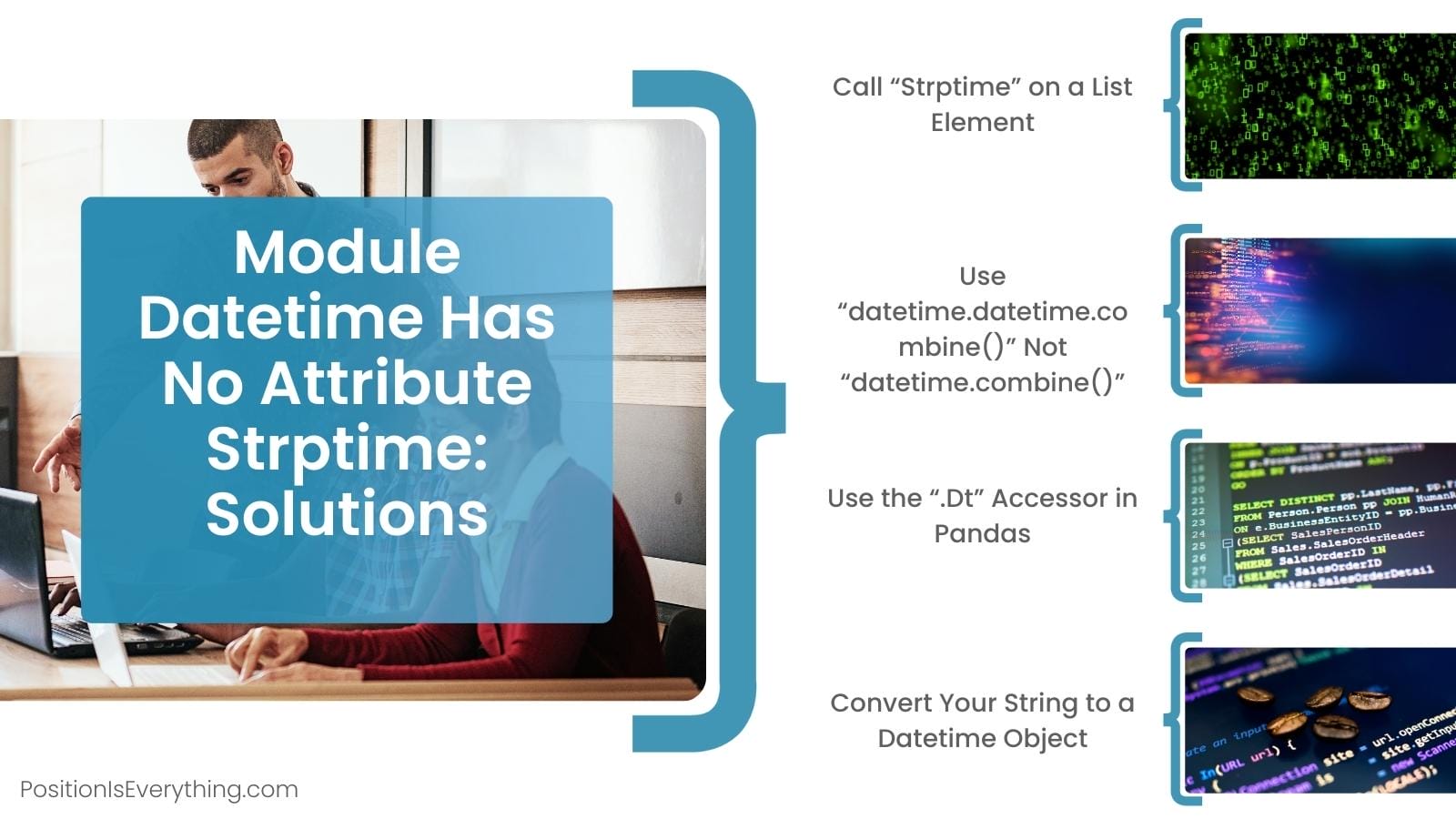Module Datetime Has No Attribute Strptime
Table of Contents:
1. Overview of the module datetime
2. Explanation of the attribute error
3. Understanding the strptime() method
4. Common causes and potential fixes for the attribute error
5. Checking the Python version to ensure compatibility
6. Updating or reinstalling the datetime module
7. Importing the necessary modules and libraries
8. Using the correct syntax for strptime()
9. Troubleshooting potential syntax errors
10. Alternative methods for parsing date and time strings using datetime
11. Further resources and documentation for datetime module
Overview of the module datetime:
The datetime module in Python allows manipulation and handling of dates, times, time intervals, and time-related calculations efficiently. It offers various classes such as datetime, date, time, timedelta, and tzinfo that provide a wide range of functionalities for working with different aspects of time. This module is essential for tasks involving scheduling, data analysis, and working with time-based data.
Explanation of the attribute error:
The attribute error “datetime has no attribute strptime” occurs when the strptime() method is called on an incorrect object or is not available in the datetime module. The strptime() method is used to parse string representations of dates and times into datetime objects. This error indicates that the module datetime does not have the strptime() method, leading to the failed execution of the program.
Understanding the strptime() method:
The strptime() method within the datetime module is primarily used to convert a formatted string representing a date and time to a datetime object. It takes two arguments: the string to be parsed, and a format string that describes the format of the input string. The format string uses special codes to represent different parts of the date and time, such as “%Y” for the year, “%m” for the month, “%d” for the day, and so on.
Common causes and potential fixes for the attribute error:
1. Checking the Python version to ensure compatibility:
It is crucial to check the Python version being used. The strptime() method is available in Python versions 2.3 and above. If you are using an older version, consider upgrading to a newer version that supports this method.
2. Updating or reinstalling the datetime module:
Sometimes, the attribute error can occur due to an outdated or corrupt datetime module installation. In such cases, updating or reinstalling the datetime module can resolve the issue. This can be done using the package manager of your Python distribution or by running the appropriate installation command.
3. Importing the necessary modules and libraries:
The attribute error can also occur if the necessary modules or libraries are not imported correctly. Ensure that the datetime module is imported using the correct syntax: “import datetime”.
4. Using the correct syntax for strptime():
It is crucial to use the correct syntax when calling the strptime() method. Make sure you are using the appropriate datetime object to call the method and using the correct format string to match the format of the input string.
Troubleshooting potential syntax errors:
If you are encountering syntax errors, ensure that the datetime object used is of the correct type. The strptime() method should be called on a datetime object and not on other data types. Additionally, double-check the format string to ensure it matches the format of the input string accurately. A small mistake in the format string can lead to attribute errors.
Alternative methods for parsing date and time strings using datetime:
If you encounter difficulties with the strptime() method or need an alternative approach, the datetime module provides other methods for parsing date and time strings. One such method is the datetime.strptime() function, which is functionally equivalent to the strptime() method.
Further resources and documentation for datetime module:
– Python documentation for the datetime module: [insert link]
– Stack Overflow: [insert link]
– Official Python forums: [insert link]
In conclusion, the datetime module in Python is a versatile tool for handling dates, times, and time-based calculations. While strptime() is a fundamental method within the module, users may encounter an attribute error if it is not used correctly or the module is not installed or updated. By understanding the causes and potential fixes for this error, users can overcome this issue and make the most out of the datetime module’s capabilities.
Datetime Module Has No Attribute Strptime
Keywords searched by users: module datetime has no attribute strptime Strptime Python, Python print datetime, Strptime() argument 1 must be str, not datetime datetime, Python datetime to timestamp, Python strptime stackoverflow, Convert string to datetime Python, Python datetime add days, Must be str not datetime date
Categories: Top 38 Module Datetime Has No Attribute Strptime
See more here: nhanvietluanvan.com
Strptime Python
The datetime module in Python provides numerous functions and classes to perform various operations related to date and time. One of the most commonly used functions within this module is strptime(). In this article, we will explore strptime Python in depth, covering its usage, formatting options, and other related aspects.
What is strptime()?
The strptime() function in Python is used to convert a string representation of a date or time into a corresponding datetime object. It stands for “string parse time”. This function is particularly useful when we need to convert user input or data stored as strings into a datetime object for further processing or calculation.
Syntax and Usage:
The syntax of strptime() function is as follows:
“`python
datetime.strptime(date_string, format)
“`
Here, “date_string” represents the string that needs to be converted to a datetime object, and “format” specifies the format of the input string. The “format” parameter is essential as it helps strptime() understand the structure of the input string.
For example, to convert the string “2022-01-15” into a datetime object, we can use the following code:
“`python
from datetime import datetime
date_string = “2022-01-15”
date_object = datetime.strptime(date_string, “%Y-%m-%d”)
“`
Supported Format Codes:
Python’s strptime() function recognizes various format codes that can be used to specify the structure of the input string. Some commonly used format codes include:
– %Y: Represents the year with a century as a decimal number.
– %m: Represents the month as a zero-padded decimal number.
– %d: Represents the day of the month as a zero-padded decimal number.
– %H: Represents the hour (24-hour clock) as a zero-padded decimal number.
– %M: Represents the minute as a zero-padded decimal number.
– %S: Represents the second as a zero-padded decimal number.
– %w: Represents the day of the week as a decimal number, where Sunday is 0 and Saturday is 6.
These are just a few examples, and additional format codes can be found in the Python documentation.
Handling Exceptional Cases:
While using the strptime() function, it is important to handle exceptional cases where the input string doesn’t match the provided format. In such cases, strptime() raises a ValueError. To handle such exceptions, we can enclose the function call within a try-except block:
“`python
try:
date_object = datetime.strptime(date_string, format)
except ValueError:
print(“Invalid date string or format specified.”)
“`
Frequently Asked Questions:
Q1. Can strptime() handle time zones?
No, strptime() does not handle time zones. It is used mainly for parsing date and time strings based on a specific format. To handle time zones in Python, you can use the pytz library or the datetime module’s timezone class.
Q2. What happens if the input string format and provided format do not match exactly?
If the input string format and the provided format do not match exactly, strptime() raises a ValueError. It requires strict adherence to the specified format.
Q3. Are there any limitations to the range of years strptime() can handle?
Python’s datetime module can handle a wide range of years, from 0001 to 9999.
Q4. Can strptime() handle time in addition to the date?
Yes, the strptime() function can handle both date and time parsing. You can specify the format code for hours, minutes, seconds, and even microseconds in the format parameter.
Q5. How is strptime() different from strftime()?
While strptime() is used to convert a string to a datetime object, strftime() performs the opposite operation. strftime() takes a datetime object and returns a formatted string representation based on the specified format.
In conclusion, the strptime() function in Python’s datetime module is a powerful tool for converting date and time strings into datetime objects. By understanding the format codes and handling exceptions, you can effectively leverage strptime() for a wide range of applications.
Python Print Datetime
Python has become one of the most popular programming languages due to its simplicity and versatility. One of the key features that makes Python stand out is its robust datetime module, which allows developers to work with dates and times effortlessly. In this article, we will delve into the topic of printing datetime in English, exploring various methods and scenarios while providing in-depth explanations. Additionally, we will address some frequently asked questions to help you further enhance your understanding in this area.
Understanding the datetime Module in Python:
Before we dive into printing datetime in English, it is crucial to grasp the fundamentals of the datetime module in Python. The datetime module provides classes for manipulating dates and times. The core class of this module is called datetime, and it offers various functionalities to work with dates and times effectively.
Using the strftime() Method:
The strftime() method allows developers to format a datetime object into a string representation according to a given format. To print datetime in English, we can utilize this method along with predefined format codes for English. Let’s take a look at an example:
“`python
from datetime import datetime
now = datetime.now()
formatted_datetime = now.strftime(“%A, %B %d, %Y %H:%M:%S”)
print(formatted_datetime)
“`
In this example, we import the datetime module and obtain the current datetime using the now() method. Then, we format the datetime object using the strftime() method and provide the desired English format by specifying the format codes. Finally, we print the formatted datetime, resulting in an output such as “Wednesday, March 10, 2022 14:55:30”.
Using Third-Party Libraries:
While Python’s built-in datetime module is powerful, third-party libraries such as arrow and pendulum offer additional functionalities and more intuitive ways to print datetime in English.
Arrow library, for instance, simplifies datetime operations and formatting. Here is an example showcasing the usage of arrow to print datetime in English:
“`python
import arrow
now = arrow.now()
formatted_datetime = now.format(“dddd, MMMM DD, YYYY HH:mm:ss”)
print(formatted_datetime)
“`
In this code snippet, we import the arrow library and utilize the now() method to obtain the current datetime. Then, we format the datetime object using the format() function and provide the English format as a string. Finally, we print the formatted datetime, resulting in the same output as the previous example.
FAQs:
Q1: Can I change the language of the printed datetime to a language other than English?
Ans: Yes, you can. The strftime() method and third-party libraries like arrow often support various language options. Simply modify the format codes or language settings within the library to achieve the desired language output.
Q2: How can I print the current date without the time component in English?
Ans: To print the current date without the time component, you can utilize the date() method of the datetime object. Here’s an example:
“`python
from datetime import datetime
now = datetime.now()
formatted_date = now.date().strftime(“%A, %B %d, %Y”)
print(formatted_date)
“`
Using the date() method, we extract the date component from the datetime object and then format it using the strftime() method with the desired English format.
Q3: How can I print datetime in a different time zone in English?
Ans: When working with time zones, third-party libraries like pytz and pendulum provide convenient solutions. You can create a timezone object and apply it to the datetime object before formatting it for English output.
“`python
import pytz
from datetime import datetime
now = datetime.now(pytz.timezone(‘Europe/London’))
formatted_datetime = now.strftime(“%A, %B %d, %Y %H:%M:%S”)
print(formatted_datetime)
“`
In this example, we import the pytz library and create a timezone object “Europe/London”. We then pass this object to the now() method of datetime, which returns the current datetime in the specified time zone. Finally, we format and print the datetime as before, but now in the English format adjusted to the new time zone.
Conclusion:
Printing datetime in English is a crucial aspect of working with dates and times in Python. In this article, we explored various methods, such as using the strftime() method from the built-in datetime module and third-party libraries like arrow. We also addressed some frequently asked questions, providing further clarity on related concepts. With a solid grasp of printing datetime in English, you can now leverage this knowledge to create date and time-related applications or scripts effectively using Python.
Strptime() Argument 1 Must Be Str, Not Datetime Datetime
Introduction:
Python is a versatile programming language that offers multiple functionalities. With its extensive libraries and modules, it has become a popular choice among developers. One such useful library is the datetime module, which enables handling of dates and times in Python. However, when working with the datetime module, you might come across an error message stating, “strptime() argument 1 must be str, not datetime.” This article aims to provide a comprehensive understanding of this error and delve into the intricacies of the strptime() function.
What is strptime() and its Purpose:
In Python, the strptime() function is used to convert a string representing a date and time to a datetime object. The strptime() function’s primary purpose is to parse a string and interpret it as a datetime object, allowing for further manipulation or calculation. The strptime() function accepts two arguments: the string to be parsed and the format string specifying the expected format of the input.
Understanding the Error Message:
The error message, “strptime() argument 1 must be str, not datetime,” indicates that the first argument passed to the strptime() function is not of the expected string data type but rather a datetime object. This happens when there is a mismatch between the input argument’s type and the expected type by the strptime() function. To resolve this error, the first argument passed to the strptime() function should be a string, not a datetime object.
Common Causes for the Error:
1. Variable Overwriting: The most common cause of this error occurs when the developer accidentally overwrites a variable initially assigned as a string with a datetime object. This happens if a variable is reused or if there is a logical error within the code.
2. Incorrect Argument Order: Another common mistake leading to this error is reversing the order of arguments while calling the strptime() function. The first argument should always be a string, and the second argument should be the format string.
3. Misunderstanding the strptime() Function: The strptime() function expects a string as its first argument. If a datetime object is passed instead, the error occurs. Developers sometimes mistakenly assume that the function can also parse datetime objects.
Resolution and Solutions:
1. Validate Variable Types: To fix the error, ensure that the variable passed as the first argument to the strptime() function is indeed a string. Check if the variable has not been inadvertently reassigned to a datetime object elsewhere in the code.
2. Check Argument Order: Double-check the order of arguments passed to the strptime() function. If the error persists, swap the arguments so that the string is provided as the first argument and the format string as the second.
3. Review Data Flow: If the error still persists, review the code’s logic and identify if there are any inconsistencies or errors causing the variable to become a datetime object during runtime. Carefully analyze the code for any possible overwriting or incorrect assignments.
FAQs:
Q1. What is the datetime object?
A1. In Python, the datetime object is a class from the datetime module that represents a combination of date (year, month, day), time (hour, minute, second, microsecond), and time zone information.
Q2. What is a format string?
A2. A format string is used to define the expected format of the input string passed to the strptime() function. It specifies the way the date and time components are represented within the string, such as %Y for a four-digit year.
Q3. Can the strptime() function parse datetime objects?
A3. No, the strptime() function is specifically designed to parse strings, not datetime objects. If a datetime object is passed, it will raise the “strptime() argument 1 must be str, not datetime” error.
Q4. Can strptime() handle various date and time formats?
A4. Yes, the strptime() function is highly flexible and can handle different formats using the appropriate format string. However, if the input string does not match the specified format, a ValueError will be raised.
Conclusion:
The “strptime() argument 1 must be str, not datetime” error occurs when developers pass a datetime object instead of a string as the first argument to the strptime() function. Understanding this error and following the suggested resolutions and solutions outlined in this article will help you handle this situation adequately. Remember to validate variable types, verify argument order, and analyze your code’s data flow to ensure a smooth execution of strptime() and datetime operations within Python.
Images related to the topic module datetime has no attribute strptime

Found 37 images related to module datetime has no attribute strptime theme
















Article link: module datetime has no attribute strptime.
Learn more about the topic module datetime has no attribute strptime.
- AttributeError: ‘datetime’ module has no attribute ‘strptime’
- AttributeError module ‘datetime’ has no attribute ‘strptime’
- module datetime has no attribute strptime ( Solved )
- module ‘datetime’ has no attribute ‘strptime’ – sebhastian
- Fix “AttributeError: module ‘DateTime’ has no attribute ‘strptime …
- module ‘datetime’ has no attribute ‘strptime’ – Statistics Globe
- Module Datetime Has No Attribute Strptime: 8 Solutions for You!
- How to Fix AttributeError: module ‘datetime’ has no attribute …
- ‘module’ object has no attribute ‘strptime’ then how to resolve it?